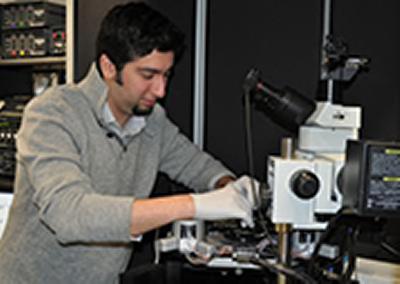New understanding of how materials change when rapidly heated

Collaboration between the University of Southampton and the University of Cambridge has made ground-breaking advances in our understanding of the changes that materials undergo when rapidly heated.
Using cutting edge equipment and specially designed MEM’s sensors on loan from Mettler-Toledo, scientists from the University of Southampton’s Optoelectronic Research Centre and the University of Cambridge’s Department of Materials Science were able to probe the behaviour of phase change memory materials, the semiconductors that store information in the next generation of electronics, as they were heated at rates up to 10,000 degree C per second.
Insight and a detailed understanding of measurement results was provided by Professor Lindsay Greer, from the University of Cambridge’s Department of Materials Science, whose analysis showed that crystal growth rates differed considerably from other materials such as glass and silicon and the behaviour of these materials on such rapid heating was not as expected.
The results, which are published this week in Nature Materials, show that crystal growth rates are much faster than we previously believed in these materials and that the growth behaviour is independent of the surroundings. While it is not surprising that properties of materials change significantly when they are shrunk to nanoscale dimensions, we now have a method of directly screening materials for improved memory performance; this means faster, smaller and less power hungry smart phones, ipods and computers are one step closer.

Professor Dan Hewak from the University of Southampton, whose team, led by Behrad Gholipour, provided the phase change materials and deposited them as very thin films, comments:
“We have been studying novel glasses and phase change materials for two decades here at the Optoelectronics Research Centre. However, our understanding of what happens when these materials are heated, that is, their crystallization and melting behaviours, has been limited to heating rates of about 10 degrees C per minute using conventional thermal analysis. In reality, in the memory devices we fabricate, heating rates are millions of times faster and it is reasonable to expect that in order to improve these devices, an understanding of their properties at the same heating rates they will be used is needed.”
Writing in the same issue of Nature Materials, Professors Matthias Wuttig and Martin Salinga at RWTH Aachen University in Germany explain why this breakthrough is so important: “Jiri Orava (Cambridge University) and colleagues now provide a completely new insight in our understanding of the fast transformations that occur in the materials that make up today’s memory devices. Reading and writing of data in optical memory such as rewriteable compact discs (CD-RWs and DVDs) and emerging new electronic memory can take place at speeds of tens of nanoseconds but our understanding of what happens when these materials are heated is based on experiments where heating rates are much slower.”
“Unravelling the mysteries of chocolate making, comprehending the formation of amethyst geodes, or producing advanced steels requires an understanding of the relevant crystallization phenomena.”